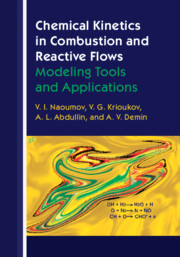Book contents
- Reviews
- Chemical Kinetics in Combustion and Reactive Flows
- Chemical Kinetics in Combustion and Reactive Flows
- Copyright page
- Dedication
- Contents
- Preface
- Acknowledgments
- Nomenclature
- Part I Basic Components of Chemical Nonequilibrium Models
- Part II Mathematical Modeling of Selected Typical Modes of Combustion
- Part III Simulation of Combustion and Nonequilibrium Flows in Propulsion and Power Generation Systems
- 7 Simulation of High-Temperature Heterogeneous Reacting Flows
- 8 Simulation of Two-Phase Flows in Gas Generators of Liquid-Propellant Rocket Engines
- 9 Pressurization of Liquid Propellant Rocket Engine Tanks
- 10 Combustion and Ionization in Spark Ignition Engines
- References
- Index
10 - Combustion and Ionization in Spark Ignition Engines
from Part III - Simulation of Combustion and Nonequilibrium Flows in Propulsion and Power Generation Systems
Published online by Cambridge University Press: 16 August 2019
- Reviews
- Chemical Kinetics in Combustion and Reactive Flows
- Chemical Kinetics in Combustion and Reactive Flows
- Copyright page
- Dedication
- Contents
- Preface
- Acknowledgments
- Nomenclature
- Part I Basic Components of Chemical Nonequilibrium Models
- Part II Mathematical Modeling of Selected Typical Modes of Combustion
- Part III Simulation of Combustion and Nonequilibrium Flows in Propulsion and Power Generation Systems
- 7 Simulation of High-Temperature Heterogeneous Reacting Flows
- 8 Simulation of Two-Phase Flows in Gas Generators of Liquid-Propellant Rocket Engines
- 9 Pressurization of Liquid Propellant Rocket Engine Tanks
- 10 Combustion and Ionization in Spark Ignition Engines
- References
- Index
Summary
Modeling and numerical simulation of combustion in the cylinders of spark-ignition and compression-ignition internal combustion engines (ICEs) provide a considerable contribution in engines engineering and the optimization of engines performance, efficiency, and emissions. This chapter demonstrates the application of the reactor approach and the chemical nonequilibrium model (Chapters 1–3) to the simulation of combustion in the cylinder of the spark-ignition ICE aiming to predict the variation in ionized particle concentration as control variables. It is known that the combustion of hydrocarbon fuels with oxidizers at high pressures and temperatures is accompanied by the output of some ionized substances. Research on the ionization in flames was started in the mid-1950s for the purpose of optimization of magnetohydrodynamic generators as well as the study of ionized particle formation in combustion products of propulsion systems, particularly in the thrust chambers and exhaust plumes of rocket engines [1, 160, 215, 227, 228]. This study was later extended to the combustion in the ICE for the purpose of employing empirical and theoretical data on the ionization of combustion products for engine performance control intended for the optimization of the combustion process, the reduction of fuel consumption, the reduction of exhaust gas emission, the optimization of the exhaust gas recirculation (EGR) process, etc. [292–305].
Information
- Type
- Chapter
- Information
- Chemical Kinetics in Combustion and Reactive FlowsModeling Tools and Applications, pp. 380 - 396Publisher: Cambridge University PressPrint publication year: 2019
